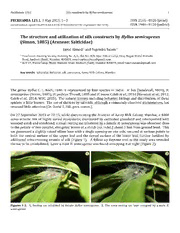
The structure and utilization of silk constructs by Hyllus semicupreus (Simon, 1885) (Araneae: Salticidae) PDF
Preview The structure and utilization of silk constructs by Hyllus semicupreus (Simon, 1885) (Araneae: Salticidae)
Peckhamia 125.1 Silk constructs by Hyllus semicupreus 1 PECKHAMIA 125.1, 7 May 2015, 1―3 ISSN 2161―8526 (print) ISSN 1944―8120 (online) urn:lsid:zoobank.org:pub:F463F534-A0CA-41DB-9F98-55A46CFB194E (registered 5 MAY 2015) The structure and utilization of silk constructs by Hyllus semicupreus (Simon, 1885) (Araneae: Salticidae) Javed Ahmed 1 and Yogendra Satam 2 1 Panchavati Housing Society, Building No. A/3, Flat No. H/8, Opp. Police Camp, Vijay Nagar, Marol Maroshi Road, Andheri (East), Mumbai: 400059, email [email protected] 2 A/3-25, Police Camp, Marol Maroshi Road, Andheri (East), Mumbai 400059, email [email protected] Key words: Salticidae, behavior, silk constructs, Aarey Milk Colony, Mumbai The genus Hyllus C. L. Koch, 1846 is represented by four species in India: H. bos (Sundevall, 1833), H. semicupreus (Simon, 1885), H. pudicus Thorell, 1895 and H. manu Caleb et al., 2014 (Keswani et al., 2012; Caleb et al., 2014; WSC, 2015). The natural history, including behavior, biology and distribution, of these spiders is little known. The use of shelters by salticids, although a commonly observed phenomenon, has received little attention (Dr. David E. Hill, pers. comm.). On 27 September 2013 at 22:15, while documenting the Araneae of Aarey Milk Colony, Mumbai, a 4000 acres eclectic mix of highly varied ecosystems, dominated by cultivated grassland and interspersed with wooded scrub and shrubland, a small resting sac inhabited by a female H. semicupreus was observed close to the petiole of two parallel, elongated leaves of a shrub (sp. indet.) about 5 feet from ground level. This sac possessed a slightly raised silken base with a single opening on one side, secured at various points to both the ventral surface of the upper leaf and the dorsal surface of the lower leaf, further fortified by additional criss-crossing strands of silk (Figure 1). A follow up daytime visit to the study area revealed the sac to be uninhabited. Later a male H. semicupreus was found occupying it at night (Figure 2). 1 2 Figures 1-2. 1, Resting sac inhabited by female Hyllus semicupreus. 2, The same resting sac later occupied by a male H. semicupreus. Peckhamia 125.1 Silk constructs by Hyllus semicupreus 2 Two additional instances of the use of a similar silken structure by this species during a period of daytime (mid-afternoon) inactivity were observed in the town of Tarapur, Maharashtra (Dr. Atul Vartak, pers. comm.). In one instance a post-molt female, as evidenced by the recently shed exuvium, was seen resting inside a silk-lined, conically folded Hibiscus leaf about 4 feet above ground level. Hyllus semicupreus is thought to be an endemic South Asian salticid (Siliwal et al., 2006), and has been recorded from Kerala in South India (Prószyński, 2014), and from the agricultural fields of Amravati District in the state of Maharashtra in Western India (Sharma et al., 2013). This is the first time that this species has been reported from the Mumbai region. Sub-adult and adult H. semicupreus were also observed and photographed on at least two other occasions in the study area, on the 22 November 2012 and 2 March 2014 (Figures 3 and 4). 3 4 Figures 3-4. 3, Hyllus semicupreus sub-adult, dorsal habitus. 4, Female H. semicupreus with dipteran prey, dorsal habitus Acknowledgements The authors would like to express their heartfelt gratitude to Mr. Sunjoy Monga, Honorary Wildlife Warden, Mumbai, naturalist and ornithologist extraordinaire, and to Ms. Rajashree Khalap, wildlife conservationist, landrace and aboriginal dogs authority, and wetland birds aficionado, for serving as inspirations, as well as their continued and unfailing support. Dr. David E. Hill is also thanked for his generous guidance. References Caleb, J. T. D., A. Christudhas, K. Laltanpuii and M. Chitra. 2014. New species of Hyllus C. L. Koch (Araneae: Salticidae) from India. Munis Entomology & Zoology 9 (2):634-637. Keswani, S., P. Hadole and A. Rajoria. 2012. Checklist of Spiders (Arachnida: Araneae) from India. Indian Journal of Arachnology, 1 (1):1-129. Koch, C. L. 1846. Die Arachniden. Nürnberg. Dreizehnter Band: 1-234, Vierzehnter Band: 1-88. Prószyński, J. 2014. Salticidae (Araneae) of the world. Online at: http://www.peckhamia.com/salticidae/, accessed 27 MAR 2015. Siliwal, M. and S. Molur. 2006. Checklist of Spiders (Arachnida: Araneae) of South Asia, including the 2006 update of the Indian spider checklist. Zoos' Print Journal 22: 2551-2597. Peckhamia 125.1 Silk constructs by Hyllus semicupreus 3 Sharma, N.R., N. E. Warghat and M. M. Baig. 2013. RAPD-PCR based study of jumping spiders from Agricultural fields of Amravati District, Maharashtra (India). Indian Journal of Arachnology 2 (1):16-29. Simon, E. 1885. Matériaux pour servir à la faune arachnologiques de l'Asie méridionale. I. Arachnides recueillis à Wagra- Karoor près Gundacul, district de Bellary par M. M. Chaper. II. Arachnides recueillis à Ramnad, district de Madura par M. l'abbé Fabre. Bulletin de la Société Zoologique de France 10: 1-39. Sundevall, C. J. 1833. Conspectus Arachnidum. Londini Gothorum. 1-39. Thorell, T. 1895. Descriptive catalogue of the spiders of Burma. London. 1-406. WSC 2015. World Spider Catalog. Natural History Museum Bern. Online at: http://wsc.nmbe.ch, version 16, accessed on 27 APR 2015.
